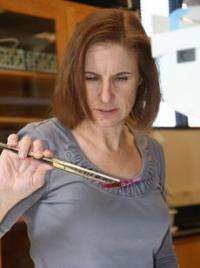Biologist's work sheds light on the shape of seahorses

(�鶹��ԺOrg.com) -- People are naturally fascinated by seahorses. Characters from King Neptune to Aquaman to the Little Mermaid have been depicted as using these enigmatic creatures as a means of transportation.
But why are seahorses shaped the way they are? Turns out, according to an Arizona State University professor, seahorses have something in common with people – they like to eat. And their unique shape may be a result of evolutionary adaptations enabling them to improve their feeding efficiency.
Lara Ferry, an associate professor in ASU’s New College of Interdisciplinary Arts and Sciences, is co-author of “An adaptive explanation for the horse-like shape of seahorses,” recently published in the journal Nature Communications. The article explains that seahorses and pipefish (aptly named because of their long, thin shape) share a common ancestor. That ancestor looked a lot more like the pipefish of today than the seahorse.
Today’s pipefish and seahorses both eat tiny shrimp, but the pipefish swims slowly forward to capture its prey while the seahorse employs a sit-and-wait approach, often with its prehensile tail attached to a reef or seagrass bed. Through experimental mathematical modeling, Ferry and her colleagues discovered that the seahorse’s peculiar head, neck and trunk posture allows for the capture of prey at larger distance from the eyes than the pipefish is capable of – an advantage if you’re not moving toward your potential meal.
So Ferry and her co-authors suggest that the seahorse’s evolution into its current form may be related to the biomechanics of prey capture. Theirs is the first proposal of a functional explanation for the body shape of seahorses.
“The paper attempts to examine one possibility for why we see such an unusual shape in nature,” Ferry said. “There is really nothing else in the sea like seahorses. Why do they look this way? We don’t really know if there is some benefit, or if it is a shape that emerged from a series of evolutionary compromises. It is probably a combination of both, but our modeling approach suggests at least one beneficial outcome regarding the ability to capture food.
“We like to think that evolution takes species along a path of improved efficiency, in terms of food gathering or other functions that promote survival. But, in actuality, we know that animals are a series of compromises,” said Ferry, who earned her Ph.D. in ecology and evolutionary biology at the University of California, Irvine.
“Animals have to use the same parts for breathing as they do for feeding, for example. This means we often see trade-offs. One skill or feature might be improved at the cost of another. Or, the features represent compromises, meaning they are not perfected for either skill but allow organisms to perform each function ‘good enough.’”
Ferry’s research interests are centered on the field of functional morphology. “Quite simply, it’s the study of organism structure – anatomy – and function – how that structure works in a particular context,” explained Ferry, who describes herself as “fascinated with how animals work.”
Ferry is most fascinated by fish; she calls them the most successful and diverse vertebrates on the planet. “Fish have been the ecological dominants in aquatic habitats pretty much since complex life evolved on this planet,” she said. “Aquatic habitats are diverse; therefore fishes as a group exhibit an incredibly rich suite of forms as necessary to meet the challenges faced in these different habitats.”
So what’s a lover of fish doing in the desert?
Ferry is interested in desert fishes, including the desert pupfish, a small, severely endangered species. “I was doing research on this family of fishes while working on the West Coast, so coming to the desert is a perfect extension of the work I was already doing.”
Ferry arrived at ASU’s West campus, the home of New College and its Division of Mathematical and Natural Sciences (MNS), for the start of the Fall 2010 semester. Her previous employer was San Jose State University’s Moss Landing Marine Labs.
But Ferry is no stranger to the Southwest. She grew up in metro Phoenix and is the daughter of ASU engineering professor David Ferry. And she said she is happy with her decision to join the MNS division.
“I love the attitude within the division and the diversity of research interests among the faculty,” Ferry said. “It’s an environment that challenges and motivates me.”
“Lara’s expertise in functional morphology has brought a new dimension to our faculty’s research portfolio,” said Roger Berger, MNS division director. “She already has attracted several undergraduate students to work in her laboratory on research projects similar to those reported in the Nature Communications paper. This supports MNS’s dedication to hands-on learning for our students.”
Ferry has provided scientific support to television nature programs, including a Discovery Channel program about the Loch Ness Monster. “The program examined the possibility that something like Nessy lived in the Loch. To the disappointment of conspiracy theorists, we concluded there was no Nessy,” she said.
Ferry also is maintaining her working relationship with the University of Washington’s Friday Harbor Labs, where she spends time in the summer teaching and conducting research. This is where she met her two co-authors for the newly published paper about seahorses. Both are faculty members at a Belgian university.
Provided by Arizona State University

















